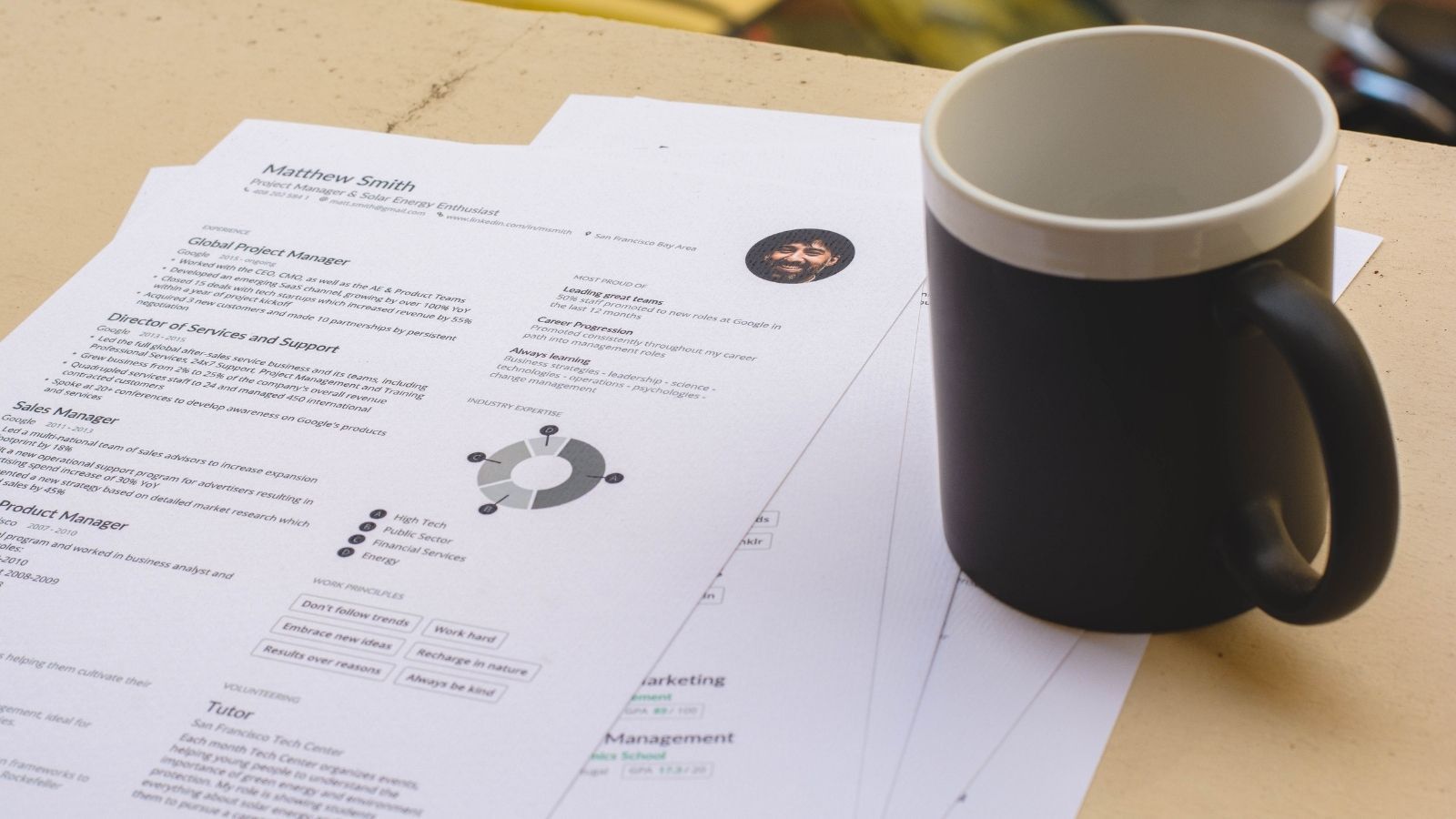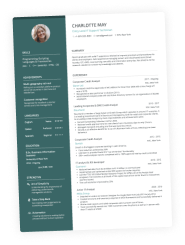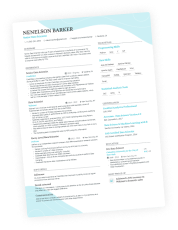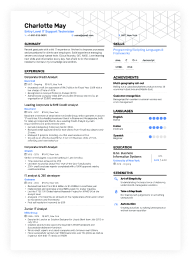Crafting a resume that reads smoothly is hard enough—choosing the right verb tense shouldn’t make it harder. Yet, many job seekers still wonder: “Should I use past or present tense on my resume?”
The truth is, verb tense can completely change how your career story is perceived. The right choice helps recruiters instantly understand your timeline and see your accomplishments clearly—and, as the American Psychological Association notes, maintaining consistent verb tense is essential for clear and professional writing.
This guide explains when to use the present, past, or present perfect tense, how to stay consistent, and how to avoid tense-related mistakes. By the end, you’ll know exactly how to make your resume sound confident, polished, and current.
Key takeaways
- Use the present tense for your current role and ongoing responsibilities.
- Use the past tense for all previous jobs and completed achievements.
- Avoid mixing tenses within the same job entry—it confuses recruiters.
- Use the present perfect tense for past actions that still have an impact.
- Stay consistent across all sections—clarity builds trust and professionalism.
- Avoid passive voice—lead with active, impact-focused verbs.
- Proofread carefully—Enhancv’s AI Resume Builder can catch tense and style errors in seconds.
Understanding verb tense on a resume
The choice between past and present tense on a resume might seem small, but it plays a major role in how clearly you communicate your experience. Recruiters skim resumes in seconds, so using the correct tense helps them instantly follow your career timeline.
When you use the present tense, you tell the reader that you’re currently performing those responsibilities. When you use the past tense, you show that those tasks and results belong to your previous positions. This logical distinction makes your experience section easy to scan and credible.
For instance:
Present tense: “Manage a cross-functional team of 10 designers.”
Past tense: “Managed a cross-functional team of 10 designers.”
That one letter difference—manage vs. managed—signals whether you’re still doing it or not. Using the right tense makes your resume sound intentional, accurate, and confident.
Why the present tense matters for your current role
If you’re currently employed, your most recent role should use present-tense verbs. This helps highlight your ongoing impact and keeps your experience sounding fresh and active.
Example:
✅ “Lead a team of sales representatives to exceed monthly quotas by 15%.”
❌ “Led a team of sales representatives to exceed monthly quotas by 15%.”
The first version communicates energy and engagement—it shows what you’re doing now. The second sounds like you’ve already moved on.
Benefits of using the present tense
- It emphasizes your current value and active contribution.
- It aligns with your LinkedIn profile, which should describe your current job in the present tense, too.
- It helps recruiters imagine you bringing those skills to their company right now.
However, even in a current role, it’s possible you’ve completed certain projects. In that case, you can mix tenses within reason—use the past tense for finished accomplishments and the present tense for ongoing duties.
Example:
- “Lead weekly strategy meetings for a 12-person marketing team.”
- “Implemented a CRM migration project that reduced manual data entry by 40%.”
This split keeps your timeline clear and helps your achievements shine without sounding awkward or inconsistent.
Why the past tense is the standard for previous jobs
All past positions on your resume should use past tense verbs. This indicates clearly that those roles have ended and your contributions are part of your professional track record.
Example:
✅ ”Developed a new onboarding process that cut training time by 25%.”
❌ ”Develops a new onboarding process that cut training time by 25%.”
Past tense creates distance—it tells the story of what you accomplished, not what you currently do. It also reads more naturally when describing completed achievements.
Why it works
- Past tense reinforces chronological clarity—your career progression is easy to follow.
- It shows you’re results-driven, not still dwelling on past roles.
- It matches industry standards—virtually all professional resumes follow this rule.
Consistency here also matters for ATS (applicant tracking systems). When your verb tenses are correct and uniform, parsing software interprets your timeline correctly, and your resume looks more refined to human readers alike.
When to use the present perfect tense
There’s a third option—the present perfect tense—for ongoing results or responsibilities that started in the past and still continue today. This tense connects your long-term impact to the present moment.
Examples:
- “Have managed client relationships that generated over $500,000 in repeat business.”
- “Have led workshops that continue to shape team collaboration and efficiency.”
Use the present perfect tense sparingly.
It’s ideal for describing:
- Long-term projects that began in a past role and still influence results.
- Ongoing professional relationships or recurring initiatives.
- Achievements that started earlier but remain part of your reputation today.
This tense bridges your career story naturally without making your past sound outdated.
The importance of consistency across your resume
Even the best resumes lose credibility when tenses jump around arbitrarily. Inconsistency suggests carelessness and makes recruiters question your attention to detail—a skill crucial in nearly every profession.
Follow this simple rule of thumb
- Current job → present tense
- Past jobs → past tense
- Long-running accomplishments → present perfect tense
Example of consistent tense use:
- “Manage product roadmap and coordinate with design and engineering teams.”
- “Developed go-to-market strategy that increased adoption by 18%.”
- “Collaborated with cross-functional teams to launch 5 new features.”
By staying consistent, your resume reads smoothly and looks deliberate—qualities hiring managers notice instantly.
Mixing tenses intentionally (when it’s appropriate)
Some careers involve ongoing contracts, overlapping freelance work, or volunteer projects that cross time periods. In such cases, it’s perfectly acceptable to mix tenses—but always with purpose and clarity.
Example:
- “Consult for two SaaS startups on UX strategy and customer acquisition.” (present)
- “Completed a 6-month redesign project for a fintech client, improving conversion rates by 22%.” (past)
Here, both tenses belong because the work overlaps in time but differs in completion status. The goal is accuracy: your resume should reflect what’s still happening and what’s already done.
PRO TIP
If you’re unsure whether to use the present or past tense for freelance or consulting work, ask:
“Am I still doing this today?”
- If yes → present tense.
- If no → past tense.
Common resume tense mistakes (and how to avoid them)
Even skilled writers make tense mistakes on resumes. Here are the most common errors—and quick fixes.
1. Using the present tense for past jobs
Switching tenses mid-sentence creates confusion. Always keep your past roles fully in the past tense.
Bad example:
- “Manage client accounts and led a sales team.”
Good example:
- “Managed client accounts and led a sales team.”
2. Mixing tenses in the same job entry
Keep all bullet points for a single job consistent, unless you deliberately separate past achievements from current duties.
Bad example:
- “Lead marketing campaigns across regions.”
- “Implemented analytics dashboard that improved decision-making by 30%.”
Good example:
- “Lead marketing campaigns across regions.”
- “Implement and monitor analytics dashboard that improves decision-making by 30%.”
3. Using passive voice
Active voice is clearer, shorter, and more powerful. It shows ownership of results rather than deflecting responsibility.
Bad example:
- “Was responsible for managing inventory.”
Example:
- “Managed inventory across 3 retail locations.”
4. Forgetting to proofread
Even one stray “manages” where “managed” belongs can make your resume feel sloppy. Always reread with tense consistency in mind—or use a grammar checker like Grammarly or Enhancv’s free and fast Resume Grammar Checker to spot errors fast.
Is your resume good enough?
Drop your resume here or choose a file. PDF & DOCX only. Max 2MB file size.
Examples: present vs. past tense in action
To visualize the difference, here’s how a role might read before and after correcting the tense.
Wrong (inconsistent tense)
Marketing Manager
BrightWave Media
2021-Present
- Managed a team of five marketing specialists to meet campaign deadlines.
- Develop a new social media strategy increasing engagement by 40%.
- Launching quarterly reports for stakeholders.
Right (consistent and clear)
Marketing Manager
BrightWave Media
2021-Present
- Manage a team of five marketing specialists to meet campaign deadlines.
- Develop and execute a social media strategy increasing engagement by 40%.
- Launch quarterly reports for stakeholders, ensuring data-driven insights.
Now, the entire section reads clean, consistent, and impactful—exactly what recruiters expect in 2026.
Special cases: education, volunteering, and projects
Some resume sections require special treatment depending on whether the activity is ongoing.
Education
Your education section should reflect whether you’re still enrolled or have already completed your studies.
- If you’ve graduated, use the past tense: “Completed a Bachelor’s in Computer Science, 2023.”
- If you’re still studying, use the present tense: “Pursuing a Bachelor’s in Computer Science, expected 2025.”
Volunteer work
For volunteer experience, choose the tense based on whether you’re actively involved or the work has concluded.
- Ongoing → “Coordinate community outreach for a local food program.”
- Completed → “Coordinated outreach events serving over 2,000 residents.”
Personal or academic projects
If a project is still in progress, use the present tense to show active engagement. For completed ones, use the past tense to demonstrate closure and results.
Example
- “Develop a personal finance app to simplify expense tracking.” (current project)
- “Developed and published a personal finance app with 1,000+ downloads.” (completed project)
How tense affects resume readability and ATS performance
A resume written with consistent tense is not only easier for humans to read but also for applicant tracking systems to process. ATS tools scan for structured, grammatically consistent entries, and irregular verb tenses or formatting can disrupt keyword extraction and increase the chances that an ATS rejects your resume.
Earlier eye-tracking research by The Ladders (2018) found recruiters spent just 7.4 seconds on an initial scan—a reminder that first impressions still decide whether your resume gets a closer look. Clear structure and consistent tenses make those seconds count.
When in doubt, read your resume out loud. If a sentence sounds like something you used to do, change it to the past tense. If it’s something you still do, use the present tense. This quick check can fix most tense inconsistencies instantly.
Quick checklist: resume tense rules
| Situation | To-do |
|---|---|
| For current jobs: |
|
| For previous jobs: |
|
| For long-term impact: |
|
| For all sections: |
|
This consistency keeps your resume professional and effortless to follow.
Aiming for perfection: final proofreading tips
Before sending your resume, give it one last tense-focused review:
- Read from bottom to top: it helps you catch errors your brain skips over.
- Highlight verbs: check if each is in the correct tense for that role.
- Ask a friend or mentor to review just for clarity and consistency.
- Run it through Enhancv’s AI Resume Builder: it flags inconsistent tenses, weak verbs, and readability issues in seconds.
- Keep tone confident: avoid fillers like “helped with” or “was part of.” Replace them with clear action verbs that show ownership.
Remember: a resume isn’t just about what you’ve done—it’s about how you present it.
Conclusion: use tense to tell a clear career story
Choosing the right verb tense is more than a grammar detail—it’s storytelling. It helps recruiters instantly see your progress, impact, and readiness for the next challenge. Use the present tense for your current job, the past tense for previous roles, and the present perfect tense only when continuity matters.
Maintaining consistent tenses makes your resume easier to read and more professional. Whether you’re updating your work history or rewriting from scratch, every verb is a chance to show confidence and precision.
Most resumes sound like they were written by time travelers—half in the past, half in the present.
Pick a tense and own it. Use the present tense to show what you’re doing now and the past tense for what’s done, but don’t obsess over the grammar police. What matters is clarity and energy—if your bullets sound alive and specific, no one’s counting verbs.
Editor’s note
Make one that's truly you.




